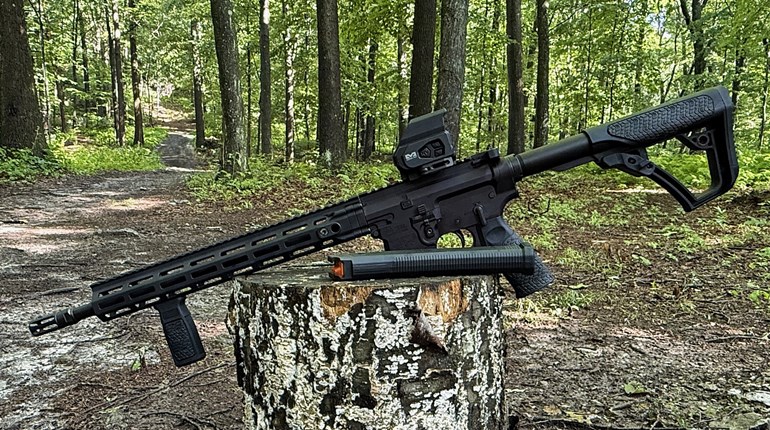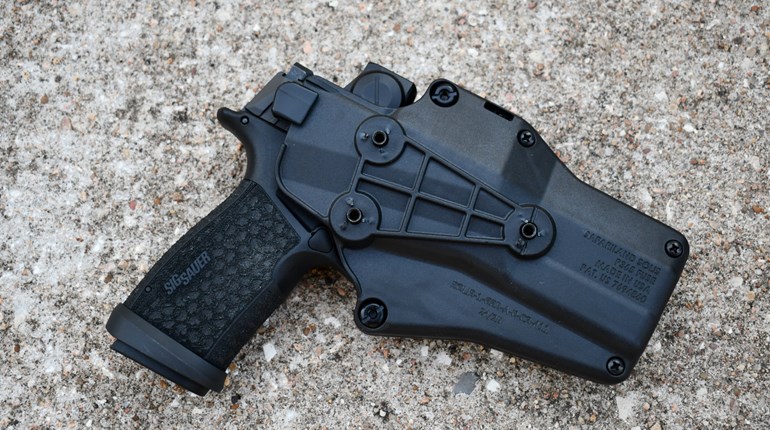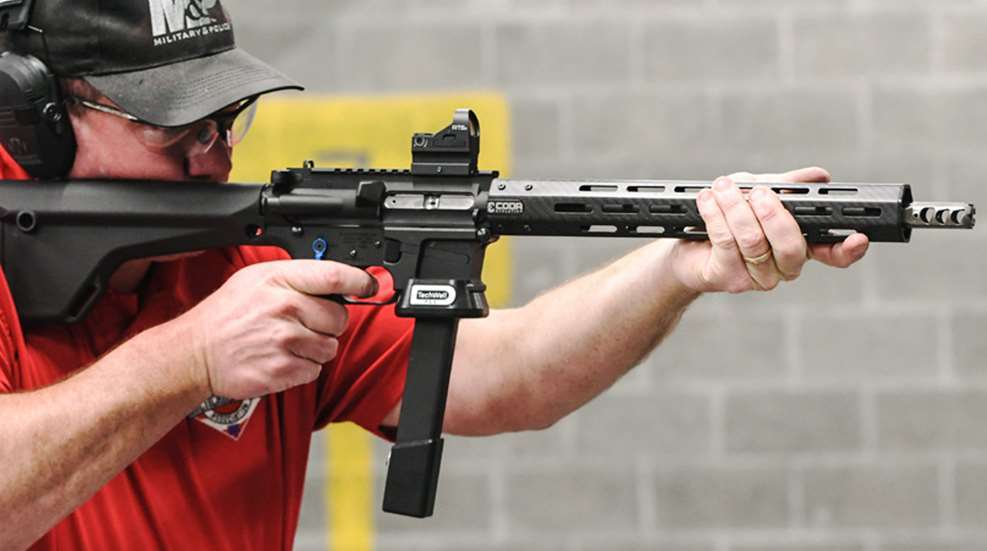
Coda Evolution is a brand-new company founded by a group of gun enthusiasts and competition shooters, headquartered in Noblesville, IN. There are several decades of experience in competitive shooting among this group; they have real competition experience and that experience has profound influence on the products that they build and sell.
For this article, we review the Lighting Series handguard for PCC (Pistol Caliber Carbine), the Fury titanium compensator and the Swift series of mag pouches. The group at Coda Evolution unanimously decided to offer compensators and handguards as their initial products, citing the need for better products in these two areas. As more people begin shooting the new division, guns and gear are increasing in availability. How does the Coda Evolution gear stack up?
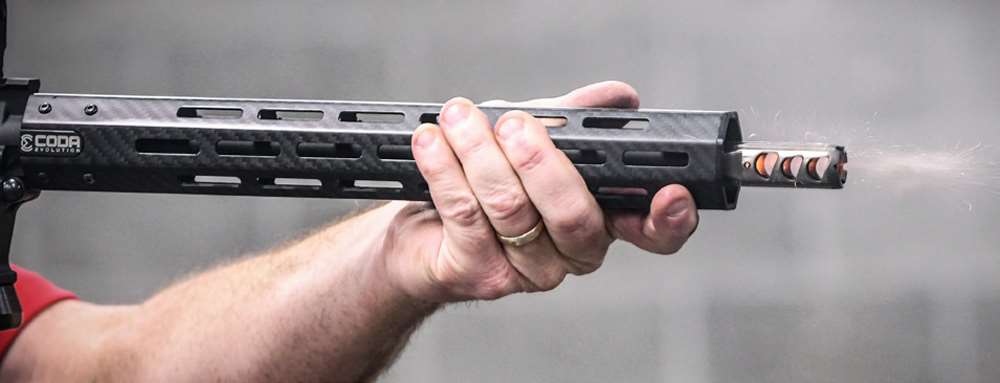
We arranged to have a handguard shipped that was already on an upper, and we just slapped the upper on Jake Martens’ PCC gun when it first arrived. Immediately, we commented that it was noticeably lighter than Jake’s upper. Both uppers were the same model and the weight difference was due to the handguard. If a lighter handguard is your idea of better, then Coda Evolutions is punching your ticket with the Lighting model. The Lightning is a 3K carbon-fiber handguard with an octagonal shape and comes in four lengths: 9.5 inch, 13.5 inch (tested), 15 and 17 inches. The outside diameter is 1.85 inches and the weight is only 7.5 ounces. The M-Lok slots allow for easy attachment of accessories and allows shooters to put accessories exactly where they want them to be. (Accessories are not an option with a lot of carbon-fiber tubes that are on the market for PCC.)
The handguard is free floated and simple to install, with no special tools needed. The proprietary barrel nut does not need to be timed and the entire installation process does not take very long at all. The Lightning is a good looking handguard, and the octagonal shape lends well to bracing against stable props or ports in 3-Gun situations. MSRP: $233-$360, depending on length.
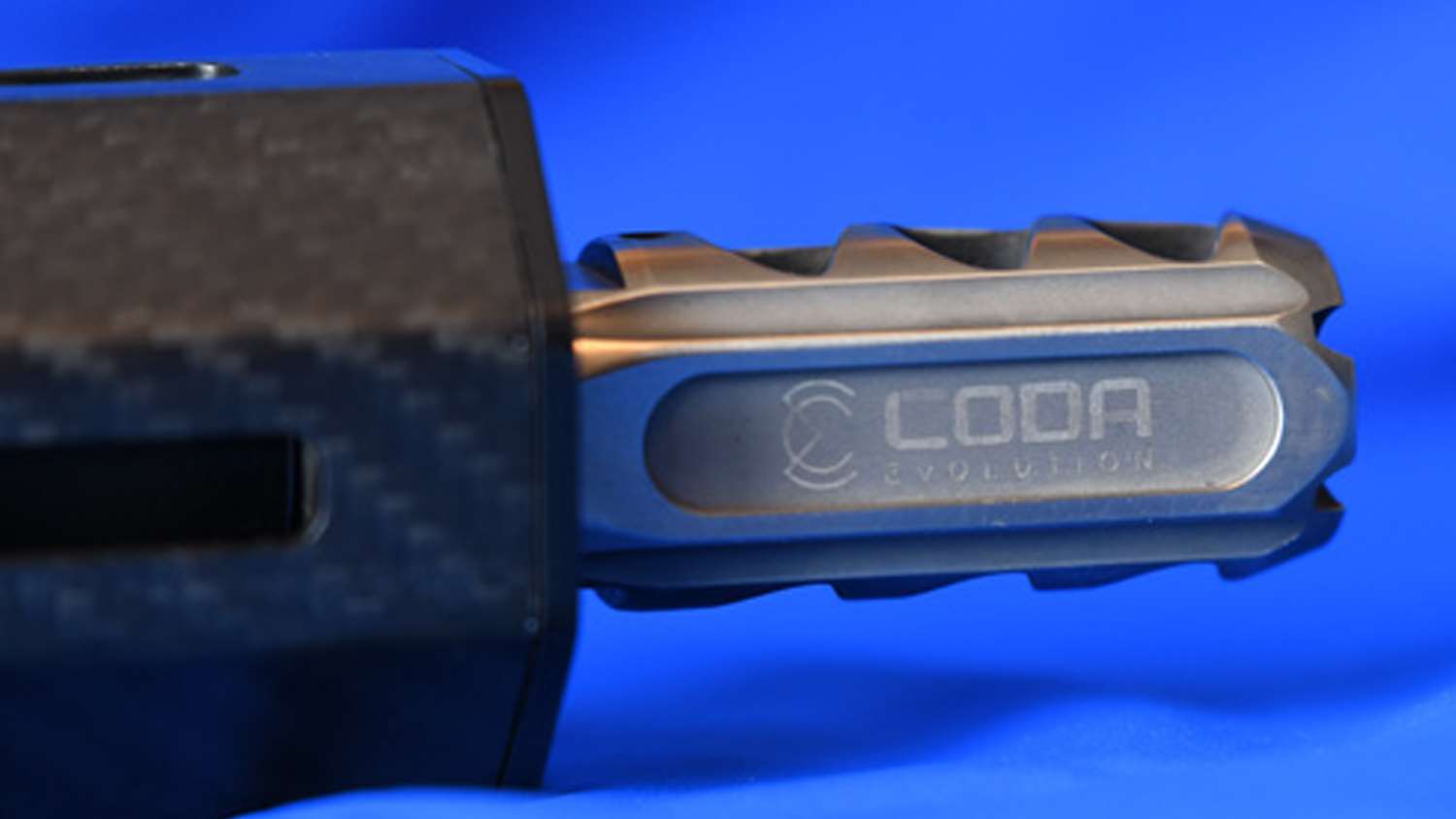
The Fury compensator has been designed and built to keep the rifle or carbine light. The titanium compensator is 45 percent lighter than steel and offers more heat resistance. Coda offers the Fury in .223 Rem., 9mm and .308 Win. at this time. It weighs in at 2.1 ounces, and 2.6 ounces for the version designed specifically for the SIG Saur MPX. There are two finishes available, the hybrid and flame anodized. The flames are added by hand, making each compensator unique. The Fury that we used has three D-shaped ports on the left and right side of the compensator that appear to direct the gas horizontally and slightly forward. The top has two circular ports that direct the gas vertically to provide the flat shooting experience for the serious competitor. MSRP: $108-$158, depending on caliber.
The compensator and the handguard are attractive, and give the impression that they are quality made and will be durable in the long run.
The Swift magazine pouches, designed specifically for long PCC magazines of the Glock and Colt varieties, come in 3.5-inch and 5.5-inch lengths, for magazines up to 33 rounds and for the 41-round extended magazines. They are designed to withstand the rigors of USPSA competition, to retain the magazine and to provide a smooth release for speed reloads. The Swift pouches come with a proprietary EPDM band system that allows for variable levels of retention, and magazines can be oriented bullets forward or bullets rearward, depending upon the shooter’s preference. The mounting holes for the Swift pouch are Tek-Lok and ELS compatible. There are multiple holes for screws on the pouch, allowing shooters to change the cant and position to match their needs. These pouches are adjustable in position and retention and can be added or removed from a belt with the ease of the proven Tek-Lok system. The guys at Coda have a well-designed pouch on the market. MSRP: $23-$27, depending on size.
Drills
There is no test like a match to prove the quality of a product. We shall see how these products perform under range conditions and match pressure. Jake and I scheduled some range time at Parabellum, where we put the Coda Evolution gear through a workout.
The first course of fire was a narrower version of Smoke and Hope, due to not having side berms to avoid shooting into the block walls. The stop plate was steel and at the proper distance, but we substituted paper USPSA targets for the rectangles. The times of our runs cannot be very meaningful in comparison to actual stage times, but they should provide some sort of baseline compared to each other. We shot 124-grain American Eagle ammunition on this stage. Jake’s five runs on Smoke and Hope were 2.13, 2.05, 1.90, 1.89 and 1.84 seconds, and the hits and holes were all there. My times on the stage were 2.35, 2.42, 2.05, 2.03 and 1.70 seconds, with all the hits and holes present as well. Jake had the better overall time, obviously, but I owned the fastest overall time.
The second stage was a slightly short and narrow version of Five to Go. We used a steel stop plate and the fourth and most distant plate was also steel; the other three plates were paper plates stapled to USPSA targets. Our targets were the right size, but space did not allow for regulation distances or width of the stage, with the fourth plate only about 18 yards away. This test required aiming the gun to get hits much more than the first stage. Jake’s times were 3.18, 2.90, 3.00, 2.91 and 2.84 seconds on this stage. My times were 3.08, 2.93, 2.49, 2.56 and 2.51 seconds. Both of us secured the hits. Normally, teasing PCC shooters is a hobby of mine, but I was beginning to have an uncomfortable feeling about how much fun this was. One stage for Jake and one stage for me, and the equipment is performing well.
Our next stage was a home-grown stage with a Steel Challenge flavor to it. We placed our two steel plates on opposite sides of the range with the maximum spread possible, and placed a USPSA target in the middle of the stage for the stop plate. The distance to the steel plates was 15 yards and the two plates were at least 15 yards apart. This little three-shot stage would make for some tough transitions. We used 150-grain American Eagle ammunition. Jake’s times were 1.99, 1.73, 1.66, 1.77 and 1.91 seconds. My times were 2.06, 2.04, 1.83, 1.99 and 1.81 seconds. Round three goes to Jake by just over half a second, and the gear is doing well.
The next test was the old standard, EL Prez. Since we have been doing Steel Challenge shooting thus far, we felt the need to add some USPSA elements to the test. Now to bring in the reload and the scoring zones on the target. In my case it is a borrowed rifle and new mag pouches. What could possibly go wrong? We did two runs each back to back on the stage. Jake went first and had 52 points in 6.25 seconds for a hit factor of 8.32. His second run was 44 points in 5.8 seconds.
After pasting targets and reloading magazines it was my turn at this classifier. Suppressing feelings of sympathy about minor scoring, I stepped to the line and I pulled off 56 points in 6.24 seconds for a hit factor of 8.9974 on the first run, 58 points in 5.71 seconds for a 10.1576 hit factor on the second. If I could shoot A’s like that all the time, minor scoring would not be a big deal at all. The Coda gear was impressive.
Our combined shooting experience of PCC in competition is pretty limited, which I plan to fix in 2019, at least in Steel Challenge and some club-level USPSA matches, but shooting these drills was a lot of fun and the ability to hit targets at speed was very repeatable. The Fury compensator was very flat-shooting, and the hits on the targets verified that fact. The dot stayed in view the whole time while shooting these stages/exercises. The three-target transition drill and Five to Go required calling the shots in order to get the hits and to do so at speed; this Fury compensator kept the gun very flat and allowed both of us to shoot just as fast as we could get the needed visual information for each shot. If you are looking for a flat-shooting and easy-to-install comp for your PCC, check out the Coda Fury. It performs very well.
At a match
There was an indoor USPSA match scheduled in December at Parabellum, which would give Jake and me a little more trigger time with the Coda Evolution gear, and would also involve movement and reloads, so this three-stage match would become a part of the testing.
Stage 1 of the match required 33 rounds to complete and required at least four shooting positions, due to the vision barrier. There were two targets that could be shot on the move, or from one of the required shooting positions, and a low port was required for shooting two targets. There were a total of 11 different targets that required three rounds each for this course of fire. The shooting area stretched across the width of the range and moved diagonally from left to right, progressing down range. The distance to targets was fairly close, ranging from seven yards for the close targets to 15 yards for the farthest. The shooter had to move about 15 to 18 yards total during this course of fire. The stage was a fair test of running and gunning indoors, and demanded control of the gun on each target.
Local PCC Grand Master and all-around good guy Greg Harrell was also shooting PCC at this match, and his performance will lend some insight to our results. Greg also uses a Coda Evolution handguard on his PCC, and is very satisfied with the product.
When asked about the handguard, he said, “It is lightweight and has a rock-solid mounting system that does not come loose like a lot of cheap carbon-fiber tubes.”
Greg won the stage with 137 points out of a possible 165 in 16.44 seconds. I came in second with 141 points and 18.44 seconds. I cannot keep up with Jake in the trigger pulling speed department. Jake has hosing speed that many people just do not have, and he is not afraid of using it, so I engaged some targets on the move to try to close the gap on speed. Jake was the most noticeable shooter visually at the match. He laid down a continuous string of fire that did not seem to stop from the beep until he stopped. While he was in the midst of this, I wondered if a reload would be necessary because of the number of rounds fired. Jake’s time was 13.65 seconds, but a paltry 114 points placed him third.
Stage 2 had the same layout, with fewer targets and fewer required positions but with four shots required per target. The match director was trying to do something different for this holiday season match and it was well received.
There were six targets in the stage and three shooting positions required, but no low port this time. Two targets could be shot on the move or from other shooting positions. Again, Greg took us both to school and won the stage with a time of 10.18 seconds and 114 out of 120 points for the high hit factor of 11.1984. I came in second place with 11.06 seconds and 108 points. I shot two targets on the move again, trying hard to keep on the pace I dropped some points as a result of shooting on the move, but was able to see the dot during the whole process. With practice, I’m confident I could shoot on the move without dropping points. The comp kept things very flat and controllable. Jake is not one to slow down just because of a few mikes on a previous stage. He gripped it and ripped through the stage in 9.33 seconds and did so without a miss. Jake’s points only totaled 88 of the possible 120 points and left him in the third position, but it was fast and fun to watch.
Stage 3 was the classifier, Tick Tock, so an unloaded start and a mandatory reload would be involved in this effort. The results were starting to be familiar. Greg won the day with a sub optimal performance for a GM, but enough to defeat the two noobs, who finished second and third, just as they had on the previous two stages – both victims of either forgetting about the hold-over with the gun at this stage or simply not believing it would be a factor. Yes both Jake and I had two mikes apiece on this stage. The gun handling was fine and the light handguard was nice for the table top pick-up and the maneuvering of the carbine. Shooting PCC with this gear was a lot of fun, and made me want to do it again.
The handguard was very comfortable and very light for swinging the gun around. On the Steel Challenge stages, the transitions are a very big deal and this handguard made it easy to swing around effectively. The handguard seems like a really solid product that is lightweight and comfortable in your hand. It has all of qualities that are desirable and has proven match performance in testing conditions and in national-level matches. So if you are looking to improve your PCC gear, give the Lightning by Coda Evolution some consideration.
It is impossible for me to speak with any experience comparing compensators, so I may be a bit out of my lane here. What I tried to do during the testing and during the indoor match was to watch the dot closely. In all of the shooting, I was able to watch the dot the entire time I was firing. There was just enough jump to the dot to call shots, but the gun was flat enough that I did not lose sight of the dot while the gun was up to my eye. The Fury compensator kept the gun very flat to allow the tracking of the dot to go that well. If an inexperienced PCC guy can do that, imagine what an experienced PCC hand could accomplish. The Fury is a flat shooter and that is the point.
The Swift mag pouches work great. I have used them in a number of club matches since they have arrived, and have used them while shooting PCC, Limited and Production divisions in USPSA matches. I have also used these mag pouches in a couple of carry gun matches that require concealment of the gun and the magazines on the belt. I love these pouches, and they are not going to be returned. What I love about them is that I can snap them onto and off my belt without removing it. The pouches have accepted Glock, Smith and Wesson and STI magazines without a hiccup. Over the holidays both my kids were shooting matches with me, and magazine pouches would have been in short supply without these from Coda Evolution being on hand. They have worked for our purposes without any issue and will be used regularly going forward.
Check out the Coda Evolution website.
Article from the March/April 2019 issue of USPSA’s FrontSight magazine.














